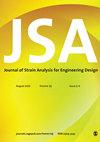Optimization of the sintering temperature, cooling time and grain size parameters to reduce residual stresses of copper-aluminum functionally graded material using response surface methodology
IF 1.4
4区 工程技术
Q3 ENGINEERING, MECHANICAL
Journal of Strain Analysis for Engineering Design
Pub Date : 2021-12-29
DOI:10.1177/03093247211068770
引用次数: 1
Abstract
One of the urgent needs for the medical, aerospace and military industries is to combine materials with heat-resistant as well as flexible structures. To create such a property, a ceramic must be placed next to metal. FGM materials have such a property in terms of thickness. Functionally graded materials (FGM) are examples of materials with different properties in the thickness direction. In the functionally graded materials, different properties can be created, by changing the percent weight of materials in each layer. It is very important to study the number of residual stresses in these materials due to the fact that several materials with different properties are combined with each other. The purpose of this study is to investigate the effect of production parameters on the number of residual stresses in the aluminum-copper FGM part and also to optimize the production process of these materials. The results indicate that the number of residual stresses decreases with increasing the sintering temperature, cooling time of the sample as well as uniformity along the thickness. In the experiments, the maximum residual stress was 171 MPa, which was obtained for a grain size of 100 microns, sintering temperature of 600°C and cooling time of 24 h and the minimum value of pressure residual stress was 120 MPa, which was obtained for grain size of 20 microns, sintering temperature of 900°C and cooling time of 48 h. Also, finite element modeling of the process was performed and shown a good agreement with experimental results.利用响应面法优化烧结温度、冷却时间和晶粒尺寸参数以降低铜铝功能梯度材料的残余应力
医疗、航空航天和军事工业的迫切需求之一是将材料与耐热和柔性结构结合起来。为了产生这样的特性,陶瓷必须放在金属旁边。FGM材料在厚度方面具有这样的特性。功能梯度材料(FGM)是在厚度方向上具有不同性能的材料的例子。在功能分级材料中,通过改变每层材料的重量百分比,可以创建不同的性能。由于几种不同性能的材料是相互结合在一起的,因此研究这些材料中的残余应力数量是非常重要的。本研究的目的是探讨生产参数对铝-铜FGM零件残余应力数量的影响,并优化这些材料的生产工艺。结果表明:随着烧结温度的升高、冷却时间的延长以及沿厚度均匀性的提高,残余应力的数目逐渐减少;实验中,当晶粒尺寸为100微米、烧结温度为600℃、冷却时间为24 h时,得到最大残余应力为171 MPa;当晶粒尺寸为20微米、烧结温度为900℃、冷却时间为48 h时,得到压力残余应力最小值为120 MPa。对该过程进行了有限元模拟,结果与实验结果吻合较好。
本文章由计算机程序翻译,如有差异,请以英文原文为准。
求助全文
约1分钟内获得全文
求助全文
来源期刊

Journal of Strain Analysis for Engineering Design
工程技术-材料科学:表征与测试
CiteScore
3.50
自引率
6.20%
发文量
25
审稿时长
>12 weeks
期刊介绍:
The Journal of Strain Analysis for Engineering Design provides a forum for work relating to the measurement and analysis of strain that is appropriate to engineering design and practice.
"Since launching in 1965, The Journal of Strain Analysis has been a collegiate effort, dedicated to providing exemplary service to our authors. We welcome contributions related to analytical, experimental, and numerical techniques for the analysis and/or measurement of stress and/or strain, or studies of relevant material properties and failure modes. Our international Editorial Board contains experts in all of these fields and is keen to encourage papers on novel techniques and innovative applications." Professor Eann Patterson - University of Liverpool, UK
This journal is a member of the Committee on Publication Ethics (COPE).
 求助内容:
求助内容: 应助结果提醒方式:
应助结果提醒方式:


